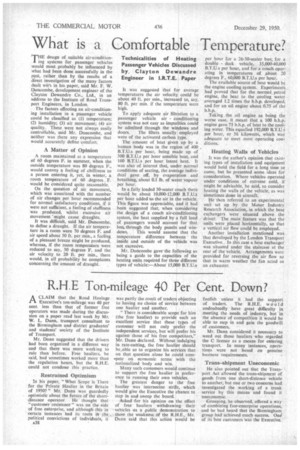What is a Comfortable Temperature?
Page 56

If you've noticed an error in this article please click here to report it so we can fix it.
Technicalities of Heating Passenger Vehicles Discussed by Clayton Dewandre Engineer in I.R.T.E. Paper
THE design of suitable air-conditioning systems for passenger vehicles would most .probably be influenced by what had been done successfully in the past, rather than by the results of a direct investigation of the many factors dealt with in his paper, said Mr. F. W. Duncombe, development engineer of the Clayton Dewandre Co., Ltd., in an address to the Institute of Road Transport Engineers, in London.
The factors affecting an air-conditioning installation in a passenger vehicle could be classified as (1) temperature; (2) humidity; (3) air movement; (4) air quality. These were not always easily controllable, said Mr. Duncombe, and neither was there any expression that would accurately define comfort.
A Matter of Opinion
A room maintained at a temperature of 60 degrees F. in summer, when the outside temperature was 80 degrees F., would convey a feeling of chilliness to a person entering it, yet, in winter, a room temperature of 60 degrees F. would be considered quite reasonable.
On the question of air movement, which was associated with the number of air changes per hour recommended for normal satisfactory conditions, if it were not sufficient, a feeling of stuffiness was produced, whilst excessive air movement 'might cause draughts.
It was difficult, said Mr. Duncornbe, to define a draught. If the air temperature in a room were 70 degrees F. and air speed about 50 ft. per min., a feeling of a pleasant breeze might be produced, whereas, if the room temperature were reduced to say, 50 degrees F. and the air velocity to 20 ft. per min., there would, in all probability be complaints concerning the amount of draught. It was suggested that for average temperatures the air velocity could be about 40 ft. per min., increased to, say, 80 ft. per min. if the temperature were high, To apply adequate air filtration to a passenger vehicle air conditioning system was not easy as impurities could be admitted through the windows and doors. The filters usually employed were of the activated carbon type.
The amount of heat given up by a human body was in the region of 400 B.T.U.s per hour, being made up of 300 B.T.U.s per hour sensible heat, and 100 B.T.U.s per hour latent heat. It was also of interest that, under normal conditions of seating, the average individual gave off, by evaporation and breathing, about 0.1 lb. of water vapour per hour.
In a fully loaded 30-seater coach there would be about 10,000-12,000 B.T.U.s per hour added to the air in the vehicle. This figure was appreciable, and it had been suggested that, when considering the design of a coach air-conditioning system, the heat supplied by a full load of passengers would account for that lost. through the body panels and win dows. This would assume that the temperature difference between the inside and outside of the vehicle was not excessive.
Mr. Duncombe gave the following as being a guide to the capacities of the heating units required for three different types of vehicle:—About 15,000 B.T.U.s per hour for a 26-30-seater bus; for a double deck vehicle, 35,000-40,000 B.T.U.s per hour, and for a coach operating in temperatures of about 20 degrees F., 60,000 B.T.U.s per hour.
The available source of heat would be the engine cooling system. Experiments had proved that for the normal petrol engine, the heat to the cooling water averaged 1.2 times the b.h.p. developed, and for an oil engine about 0.75 of the b.h.p.
Taking the oil engine as being the worse case, it meant that a 100 b.h.p. engine gave 75 b.h.p. of heat to the cooling water. This equalled 192,000 B.T.U.i per hour, or 56 kilowatts, which was adequate to meet most operating conditions.
Heating Walls of Vehicles
It was the author's opinion that existing types of installation and equipment would hold the field for a long time to come, but he presented some ideas for consideration. Where vehicles operated under conditions of extreme cold, it might be advisable, he said, to consider heating the walls of the vehicle, as was sometimes done in aircraft.
He then referred to an experimental unit set up by the Motor Industry Research Association, in which the heat exchangers were situated above the driver. The main feature was that the units were placed horizontally, so that a vertical air flow could be employed.
Another installation mentioned was that developed by the London Transport Executive. In this case a heat exchanger was situated under the staircase at the rear of the vehicle. Arrangements were provided for reversing the, air flow so that in warm weather the fan acted as an exhauster.




















































































